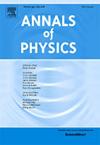Quantum systems in the hyperbolic phase-space: Explicit maps, differential form of the star product and their applications
IF 3
3区 物理与天体物理
Q2 PHYSICS, MULTIDISCIPLINARY
引用次数: 0
Abstract
We obtain a closed-form expression for the -parametrized mapping kernels for the phase-space representation of quantum systems with the SU(1,1) symmetry group, in terms of an expansion over the appropriate tensor operators, which enables us to express the kernels in terms of continuous dual Hahn polynomials. Using this representation, we derive an explicit differential form of the star-product for the SU(1,1) map, which is expandable in the inverse Bargmann index and plays the role of the semiclassical parameter in hyperbolic phase space. This formulation allows us to analyze quantum dynamics through evolved phase-space distributions that obey a Moyal-like equation. We illustrate the star-product by deriving the Bopp operators, which represent the action of the group generators on the kernels, and by discussing the symplectic-like structure of the Moyal equation for Hamiltonians that are linear or quadratic in the SU(1,1) generators. We analyze the semiclassical limit of the Moyal evolution equation and show that, over short-time quantum dynamics, the evolution of the initial distribution along classical trajectories reproduces the quantum behavior; the magnitude of quantum corrections depends on the chosen map and is minimal for the Wigner map. Examples of applications of the developed formalism to the analysis of quantum dynamics governed by non-linear Hamiltonians are discussed.
双曲相空间中的量子系统:显式映射、星积的微分形式及其应用
我们得到了具有SU(1,1)对称群的量子系统相空间表示的s参数映射核的闭形式表达式,通过在适当张量算子上的展开式,使我们能够用连续对偶Hahn多项式表示核。利用这种表示,我们导出了SU(1,1)映射的星积的显式微分形式,该映射在逆Bargmann指数上可展开,并在双曲相空间中起半经典参数的作用。这个公式允许我们通过演化的相空间分布来分析量子动力学,这些相空间分布服从一个类似摩尔方程。我们通过推导Bopp算子来说明星积,Bopp算子表示群生成子对核的作用,并通过讨论SU(1,1)生成子中线性或二次哈密顿量的Moyal方程的类辛结构来说明星积。我们分析了Moyal演化方程的半经典极限,表明在短时间量子动力学中,初始分布沿经典轨迹的演化再现了量子行为;量子修正的大小取决于所选择的图,对于维格纳图来说是最小的。本文讨论了发展的形式主义在非线性哈密顿量控制下的量子动力学分析中的应用实例。
本文章由计算机程序翻译,如有差异,请以英文原文为准。
求助全文
约1分钟内获得全文
求助全文
来源期刊

Annals of Physics
物理-物理:综合
CiteScore
5.30
自引率
3.30%
发文量
211
审稿时长
47 days
期刊介绍:
Annals of Physics presents original work in all areas of basic theoretic physics research. Ideas are developed and fully explored, and thorough treatment is given to first principles and ultimate applications. Annals of Physics emphasizes clarity and intelligibility in the articles it publishes, thus making them as accessible as possible. Readers familiar with recent developments in the field are provided with sufficient detail and background to follow the arguments and understand their significance.
The Editors of the journal cover all fields of theoretical physics. Articles published in the journal are typically longer than 20 pages.
 求助内容:
求助内容: 应助结果提醒方式:
应助结果提醒方式:


